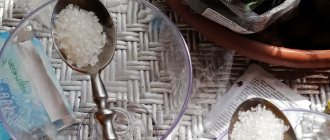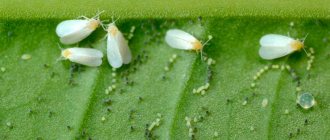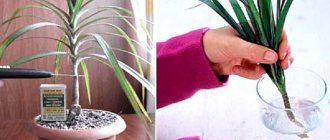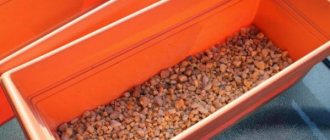The popularity of indoor plants is due to their decorative qualities. They attract attention and cause admiration. Flowers with their bright shades can decorate and enliven any interior of a room and give it sophistication.
In addition to decorative functions, they can improve the microclimate in the room, moisturizing and purifying the air, and have a positive effect on a person’s well-being, helping to fight stress and relieve nervous tension. In order for house plants to delight you for a long time, it is important to carry out all necessary agrotechnical measures in a timely manner, including replanting.
When is the best time to replant plants?
In order to find out when to replant indoor flowers and whether there is a need for it, you should look at a couple of external factors that may appear if the plant already requires replanting.
The process of replanting a houseplant
You should pay attention to:
- The soil dries out too quickly after watering. This indicates that the root system has grown very much and a larger container is needed.
- Drainage holes - If roots are pushing out through these, this is a sign that a larger container is needed.
- Lack of growth or its strong slowdown.
- The appearance of diseases in the plant.
- Deterioration of the quality of the soil in the pot.
- Poor state of the root system.
It is important to remember that it is best to replant plants at certain time periods, otherwise there is a risk of harming the flower.
For example, it is worth changing the soil of recently purchased plants, but not immediately after purchase, but after a couple of weeks or a month. Because the plant has already experienced severe stress and climate change.
Attention! When purchasing a plant, it is necessary to allow the representative of the flora to adapt a little to its surrounding conditions and only then replant.
When can you replant indoor flowers according to the seasons?
As for the appropriate time of year for replanting, representatives of botanical sciences recommend replanting plants in mid-spring, that is, at the end of March, in April or at the beginning of May. Winter is the most unfavorable time of year for soil renewal. Under no circumstances should you replant flowers in January or December; in February the procedure is carried out in exceptional cases.
Also, you should not renew the soil if the plant begins to bloom (as a rule, this happens in the summer, in June or July), it is better to postpone this matter until later.
Experts advise adhering to a certain plant replanting cycle, as follows:
- Long-lived flowers should be replanted at least once every 2 years.
- Indoor plants are quite unpretentious and require replanting every 3 years.
- Well, cacti and their brothers can be in the same container for more than 5 years.
To fully comply with all the nuances, you can also resort to the lunar calendar. After all, plants are very whimsical creatures and perceive any external influences.
The lunar calendar for May 2022 will tell you favorable days for transplants
Lunar calendar for 2022
To shorten the adaptation period after transplantation and achieve gorgeous flowering, you can take into account the instructions of the lunar calendar. This satellite of the Earth is capable of influencing all life on the planet, even the emotional and physical state of a person depends on the Moon. Care for indoor plants planned in accordance with the lunar calendar can ensure their well-being and give their owners delight and pleasure.
Transplantation carried out according to lunar instructions will have a positive effect on the flowering period.
It is important to use only the current calendar for the current year, and not last year’s. Since those days that were successful last year may be prohibited this year.
Also read: Replanting an orchid correctly: step-by-step instructions with photos
In addition to good and bad dates for transfer work, there are days that are considered neutral. These days it is allowed to carry out operations with ornamental plants, but the result will be average. This will not harm the shoots, but it will not help them fully survive the manipulation.
How to choose the right pot for replanting
Pests of indoor plants and diseases of indoor flowers
On the modern gardening market there is simply a huge variety of varieties of pots for every taste and color, of all materials and shapes.
When choosing a new pot for a plant, you need to adhere to the basic rules:
- The new container should be slightly larger than the previous pot, about 2-3 cm. You should not give the plant too much free space, otherwise it will direct its forces to fill the space with roots, and the shoots will fade into the background.
- It is best to choose pots of light shades for plants, otherwise the flower may heat up too much in the sun.
Replanting is necessarily accompanied by disinfection of the pot.
Ceramics or plastic
Ceramic containers are famous for the fact that they allow air to pass through better and absorb moisture; their advantage is that they do not suffer from rapid freezing or heating. But the downside of such containers is that they are very fragile and quite expensive. Before planting a plant in a clay pot, it is best to moisten the walls of the container with water, because clay, as mentioned above, absorbs moisture very well.
Plastic plant pots
Plastic pots are famous for the fact that they are very light, but at the same time durable. At the same time, they do not absorb moisture and it becomes much easier to fill the plant with water. In general, plastic is a cheaper material than ceramic. In fact, it also looks cheap, which turns off many.
For reference! Both types of pots perform well in operation and there is no clear answer as to which one to choose. Each flower owner must decide for himself.
Means for normalizing soil acidity
Soil acidity determinant or PH indicator - shows the amount of hydrogen ions in the soil. Soil acidity affects the uptake of water by roots and the absorption of nutrients. The neutral acidity indicator is PH -7. The lower the indicator, the more acidic the soil is.
| Soil classification | |
| very acidic soils | pH 3.8 - 4.0 |
| highly acidic soils | pH 4.1 - 4.5 |
| moderately acidic soils | pH 4.6 - 5.0 |
| slightly acidic soils | pH 5.1 - 5.5 |
| close to neutral soil | pH 5.6 - 6.9 |
Most often, indoor plants love neutral or slightly acidic soil, but there are many types of flowers that love more acidic soil (azalea, hydrangea, lupine).
Acid-base indicator
To determine the acidity of the soil, you can use litmus paper and a solution of soil in water; if the paper turns red, the soil is acidic; if it turns green, it is alkaline.
In highly acidic soil, plants lack nutrients, the work of all beneficial bacteria stops, and the plant quickly dies. Too alkaline soil is also not very good.
Ways to increase acidity:
- adding citric acid (0.5 tablespoon per 2.5 liters of water)
- adding malic acid (10 g per 1 liter of water)
- adding oxalic acid (1g per 2 liters of water)
- application of fertilizers (superphosphate, peat, sulfur sulfates)
Ways to reduce acidity:
You can reduce the acidity of the soil by adding chalk and special preparations and fertilizers containing calcium and magnesium (cement dust, slaked lime, ground limestone, fluff). They improve soil quality and normalize acidity. But all this does not happen immediately; lime works in the soil for several years.
Preparation of drainage and soil mixture
A good soil mixture is the key to successful and healthy growth of indoor plants. The type of soil mixed depends on the specific plant for which it is intended.
Classic earth mixture
Automatic watering for indoor plants - do it yourself
For many plants, a classic soil mixture is suitable. The so-called “mix” of leaf soil or humus, garden soil, peat and river sand. All “ingredients” are mixed in equal quantities to each other, that is, 25 percent each.
If problems arise with river sand, you can easily replace it with perlite. Botanists recommend adding a little expanded clay to the resulting soil, after which everything needs to be mixed. This soil is suitable for any ficus and other indoor plants.
Soil mixture for ferns
The soil for ferns differs from the classic one in that it must have an acidic environment.
It usually consists of leaf soil (1/4 of the total volume) and humus (1/4). The remaining 50 percent is covered by heather soil. To all this you need to add a little hydrogel so that the moisture does not stagnate.
Earth mixture for succulents
A characteristic feature of such soil is that the moisture inside it should not stagnate. Succulents are very sensitive to soil and therefore require great care when composing.
River sand will take up about 1/3 of the entire mixture, the other third will be taken by compost, and finally, the remaining part is divided in half between perlite and peat.
Drainage
Properly designed drainage during transplantation is the key to good flower growth; there is nothing complicated about it.
Attention! Typically, drainage is poured in a layer of 1 to 3 centimeters, at the very bottom of the pot.
It is best to use pebbles, gravel or expanded clay as drainage, and the whole thing is seasoned with vermiculite and agroperlite for better moisture transmission through the soil.
Drainage for indoor plants
Do we make it ourselves or buy substrate?
In this section, I will compare the advantages and disadvantages of making your own soil mixture from street soil and buying factory-made peat-based soil, and also sum up the results.
| Advantages | Flaws | |
| Street soil (garden soil, mole soil, from under spruce trees) | Shareware Organic (especially important for those who do not use mineral fertilizers and want to consume organic vegetables) Need to water and feed less often | The need for sterilization |
| Factory soil based on peat | Simplicity (no need to look for where to dig up soil) Year-round availability Lower weight | The extraction of peat and the production of mineral fertilizers harms the environment Price Earlier and more frequent fertilizing due to rapid depletion of nutrients Peat is difficult to saturate with moisture after severe drying out. Poor stability of pots with large plants Not suitable for growing organic vegetables (not even recommended for seedlings) |
How to transplant flowers at home correctly
How often do you need to water indoor plants?
In principle, replanting a plant is easy, but not everyone can do it correctly, taking into account all the factors. The land plays the biggest role in this matter. After all, it depends on it whether the flower will bloom and smell fragrant, or whether it will begin to hurt or die.
Removing a plant from a pot
To remove a flower from a pot, you need to make sure that the earthen ball is moist and viscous. This will make it easiest to remove the plant from the pot.
To pull out a flower, you need to pass the crown of the plant between your fingers and, holding the soil, remove the lump, pressing on the sides of the container if the pot is made of plastic.
If not, then you need to tap the walls of the pot with progressive light movements, turning it around its axis, and then try to tap on the bottom of the container.
Removing a plant from a pot
Inspection and pruning of the root system
It is worth cutting off the roots of a transplanted flower only as a last resort, if the root system is diseased and there are affected areas. After trimming, it is better to treat the cut areas with crushed activated carbon.
Post-transplant care requirements
After transplantation, a flower requires a rather reverent attitude. It is necessary to constantly monitor its condition, spray it with water from time to time, look at how the plant behaves, whether growth is observed, etc.
You can spray the transplanted flower with a special preparation called Zircon once every 7 days. It helps reduce plant stress and strengthen its root system.
Watering should be done less frequently than usual so that the root system strengthens and grows further, in search of moisture.
Attention! You should start feeding the flower only a month or more after transplantation.
Complex emergency transplant
A difficult emergency replanting of home flowers is a necessary measure caused by acidification of the soil in the flower pot, rotting roots or severe damage to the plant.
Before resorting to this measure, you need to try all possible ways to save the flower, use insecticides, other drugs, dry the earthen ball, etc.
It is worth remembering that such a transplant is very dangerous for a plant and can either help it or completely destroy it.
If nothing helps, but you really want to save the flower, then a complex emergency transplant is the only option. The procedure for preparing a plant for emergency transplantation:
- You need to remove the plants from the pot.
- Wash the roots of the plant until the smallest particles of contaminated soil are removed.
- Tap the substrate.
- After removing all the soil, it is necessary to conduct a full inspection of the plant in order to remove (cut off) the affected parts if there are infected and diseased roots.
- When cutting off each affected area with a clean knife, you need to cover the cut areas with crushed coal.
- After removing all diseased roots, it is best to place the rhizome in warm water for half an hour.
- Next comes the process of disinfecting the root part of the flower with a fungicide or potassium permanganate by placing the plant in such a solution for 40-60 minutes.
- Disinfected roots should be treated with crushed coal.
View of the extensive root system
After completing all of the above procedures, the flower can be transplanted into a new container; this must also be done following several rules:
- Availability of a new, clean pot, treated with boiling water and a solution of potassium permanganate.
- A new drainage should be laid at the bottom of the container, sprinkled with sand on top.
- After preparing the pot, you need to plant the flower itself.
- The roots are carefully unraveled and placed evenly in the pot.
- After complete, careful planting, the soil is filled up.
- The flower is placed in a dark corner at normal room temperature.
Attention! A plant that has undergone an emergency difficult transplant does not need to be watered for 2-3 days and only lightly watered on the 3rd day, slightly moistening the soil.
After an adaptation period, the flower can be transferred to its previous care, but not immediately. You should start feeding the plant after the first signs of its growth appear.
Timely care for your pet can prevent any illnesses and the need for an emergency transplant will not arise at all.
Watering with a strong solution of potassium permanganate
Spilling a pink solution of potassium permanganate is one of the easiest ways to disinfect the soil. Dissolve it in a proportion of three grams per ten liters of water. Spray the soil with this solution. Pots and seedling boxes are also treated with potassium permanganate.
Potassium permanganate solution
A quick and simple method, manganese after processing becomes a fertilizer, but this method is ineffective and is not able to completely sterilize the soil.
Transshipment of plants as a method of transplantation
Transshipment is another way to replant home flowers. Its characteristic feature is that it is suitable only for flowers with a closed root system. This method of transplantation allows the least trauma to the roots of the plant and therefore it is called gentle.
The transshipment process has several steps:
- Preparing the seat. The new pot should be only slightly larger than the previous one (about 2-3 cm). You should not immediately choose a large container, because the flower may die due to the fact that the root system does not have time to fully grow into the ground and it will turn sour.
- It is necessary to disinfect the new pot with boiling water.
- After laying a small drainage, crushed stone or pebbles are best suited for these purposes.
- Next, sprinkle the soil, approximately one third of the total volume.
- The plant is carefully removed from the previous container and planted in a new pot, sprinkled with soil along the way.
- Next comes watering.
It should be remembered that the roots of the plant should not be left in the open air for a long time, as this can lead to harmful consequences.
Author's word
Previously, for indoor gardeners, the question of choosing a substrate for growing flowers at home was simple. They took garden soil, or that which the mole had dug up, or under spruce and pine trees in public gardens and city parks.
Now this is the lot of people of the “old school”, avid amateurs, conscious people or progressive youth.
Now many gardeners, especially those living in large cities, most often use purchased soil for planting, replanting plants and growing seedlings. Therefore, more attention will be paid to it in the article.
A special place in the preparation of the soil mixture is occupied by additional components that are used to increase looseness, fertility or change acidity. A separate chapter will be devoted to them.
At the end of the article, I will consider the advantages of each option and tell you what I chose for myself.
Tools and materials for transplantation
There is no universal set of tools for transplantation; many people use improvised means.
As a rule, when replanting, you need clean containers, pots or containers, and you may also need a knife, scissors and baking powder. Well, of course, during replanting you simply need fresh soil and material for drainage.
Some positions can be optionally supplemented, but in general this set of tools is quite sufficient.
Set of tools for transplanting plants
What to do if transplantation is impossible
In exceptional cases, it will not be possible to replant your favorite plant. Perhaps the flower is simply huge or is very sick, and replanting can make it worse.
In such cases, you can try changing only the top part of the soil in the pot. This should be done to the extent that the size of the pot allows. Such a change in soil, although minor, can have a positive effect on the growth and healing of the plant.
As mentioned earlier, replanting indoor plants is not the simplest process as it seems at first glance. But delving a little deeper into the nuances that you may encounter during this lesson, it becomes clear that you need to approach this matter extremely carefully and responsibly.
Moon phases
The moon revolves around the Earth. We observe its surface from different angles. She herself does not give light. Looking at the satellite, we see how sunlight is reflected from its surface. Depending on the degree of its illumination during rotation, we see the Moon in different forms, called phases. There are several phases:
- new moon. The time the Moon is between the Earth and the Sun. The body of the Moon is not visible from Earth;
- growing. Increasing the area of solar illumination of the lunar surface. Lasts approximately 14-15 days. It is easy to determine by looking at a celestial body. If you mentally draw a stick and see the letter P, this will indicate a growing stage;
- full moon. Full illumination of the satellite by the Sun;
- decreasing. Decrease in area illuminated by the Sun, visible from Earth. If the shape in the sky looks like the letter C, this is a sign of an aging Moon.











